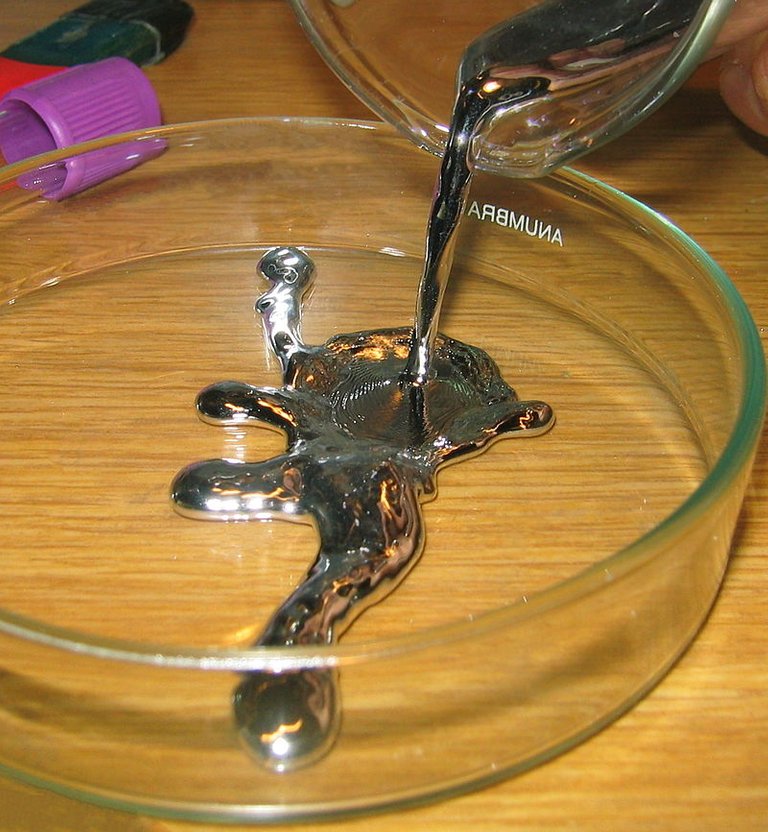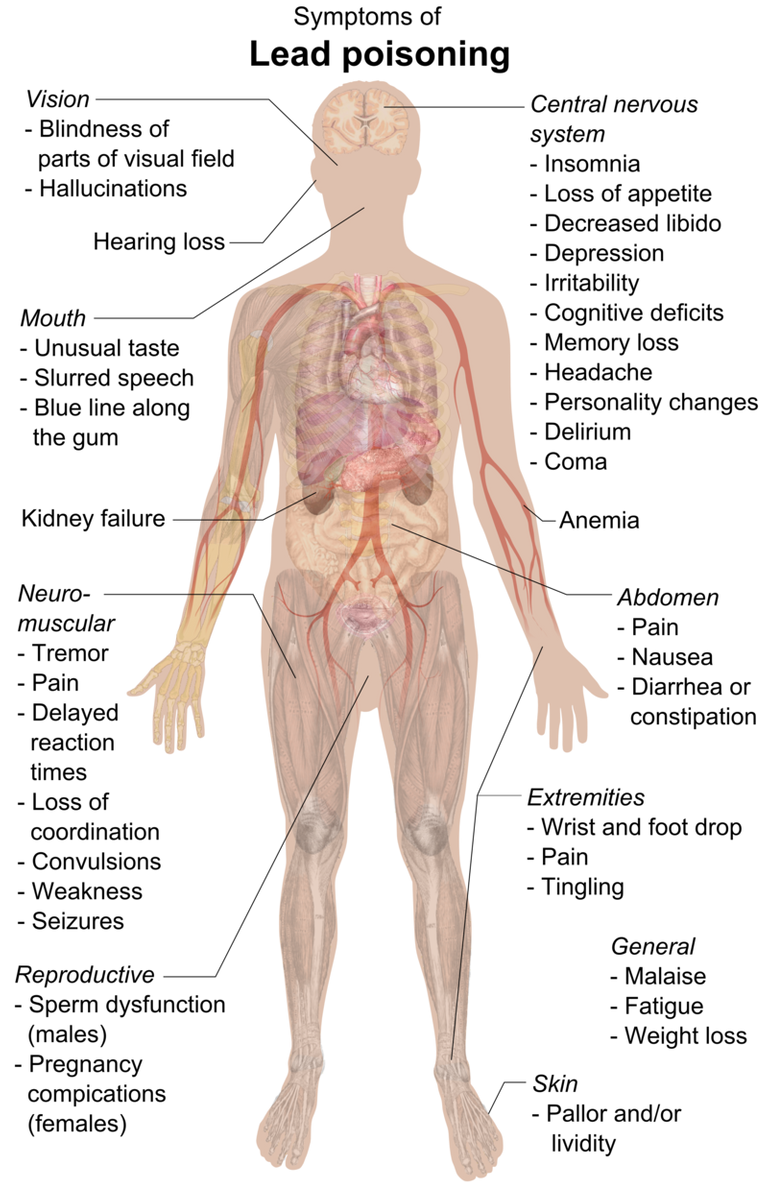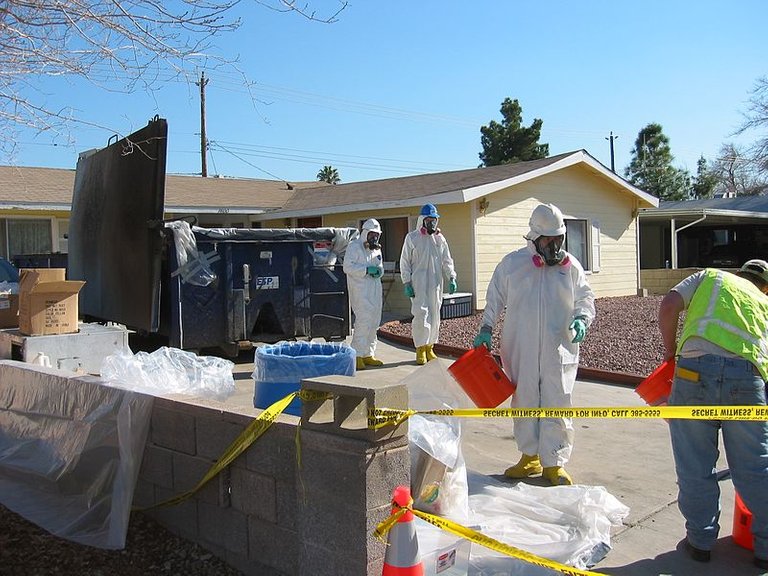Heavy Metal Poisoning | A Silent Killer
Hello Hivers!
So I don't talk about it much, but I am a medical student in my final year. I write medical articles on my blog and decided to try writing one on hive. So welcome to my first official medical article on the blockchain.
Heavy Metal poisoning is a very rare clinical condition and I myself have seen only one case of lead poisoning in the clinic directly.

Element mercury (Hg), liquid form. By Bionerd - Own work, CC BY 3.0, Link
Clinically, the term "heavy metal" has been used as a general term for those metals and semi-metals with potential for human or environmental toxicity.
In actual definition though, heavy metals are chemical elements that have specific gravity that is 5 times that of water.
Wikipedia generally defines heavy metals as
metals with relatively high densities, atomic weights, or atomic numbers.
What then is Heavy Metal Poisoning?
Heavy metal poisoning is basically the toxic accumulation of heavy metals in the soft tissues of the body. Soft tissues are found throughout the body and they comprise generally of other tissues asides bone tissue and the teeth (which comprises of tooth enamel, dentin, and cementum).
There are many types of soft tissue, including fat, muscle, fibrous tissue, blood vessels, lymph vessels and nerves. Soft tissues surround, support and connect organs and other tissues in the body.
Clinical Presentation
The signs and symptoms of heavy metal toxicity may vary depending on the nature of the metal involved and the quantity exposed to.
Some general and non-specific symptoms include:
- Nausea and vomiting
- Metallic taste
- Diarrhea
- Headache
- Abdominal pain
- Sweating

Symptoms of lead poisoning. By Mikael Häggström - Own work, CC0, Link
The affected person may also appear with some specific signs which can be elicited upon clinical examination. They include:
- Blue-black line in the gum
- Impairment of cognitive function - refers to multiple mental abilities, including learning, thinking, reasoning, remembering, problem solving, decision making, and attention.
- Impairment of motor function like standing, walking, going up and down stairs, running, swimming, and other activities that use the large muscles of the arms, legs, and torso.
- Impairment of language skills which are listening, speaking, reading, and writing.
Treatment of Heavy Metal Poisoning
The main treatment of heavy metal poisoning is to stop the exposure to the metal.
Once a heavy metal poisoning is suspected, it is important to start treatment as soon as possible to minimize long-term damage to the nervous system and the gastro-intestinal tract.
The patient would be transferred to an emergency room as it is considered a medical emergency
The treatment for most heavy metal poisoning is chelation therapy using a chelating agent. A chelating agent specific to the particular heavy metal is administered orally, intramuscularly or intravenously.
These chelating agents act by causing the toxic heavy metal to bind with the drug and be excreted in the urine.
The 3 most common chelating agents are:
- Calcium EDTA (Calcium Disodium Versenate)
- Dimercaprol [BAL-British Anti-Lewisite]
- Penicillamine
Chelation therapy may be lengthy and is effective in lead, mercury and arsenic poisoning. There is although no effective treatment for cadmium poisoning, however it can be managed symptomatically.
Treatment should also be symptomatic and supportive. Gastric lavage may be helpful in some cases. It is a procedure where by the stomach is pumped up in other to remove some of the ingested content. This is particularly helpful in acute cases of oral ingestion where the heavy metal is still in the stomach.
In the case of inhaled poisons, affected individuals should be removed from the contaminated environment and placed on respiratory support.
It is important to use masks, face shield, boots and protective clothing to protect from occupational exposure especially fro workers who directly come in contact with heavy metals.
In cases of swelling of the brain (cerebral edema), treatment with a diuretic called Mannitol, and corticosteroid drugs, along with intracranial monitoring, is required.
Kidney failure may require dialysis or other forms of renal replacement therapy; kidney transplant may be considered in extreme cases.
In conclusion, heavy metal poisoning is a very rare clinical presentation and this makes it very easy to miss or misdiagnose. You can go a long way though by protecting yourself especially if you belong to one of the classes of people constantly being exposed to these toxic metals.

EPA workers clean up residential mercury spill in 2004 By USEPA Environmental-Protection-Agency - EPA workers clean up residential mercury spill, Public Domain, Link
REFERENCES
- Hoodaji, Mehran & Ataabadi, Mitra & Najafi, Payam. (2012). Biomonitoring of Airborne Heavy Metal Contamination. 10.5772/32963.
- Wikipedia: Heavy Metals
- Wikipedia: Vitamin B12
- Wikipedia: Electron Transport Chain
- Medscape: What is the pathophysiology of heavy metal toxicity?
- Medscape: Heavy Metal Toxicity
- Science Direct: Cognitive Functioning
- rarediseases.org: Heavy Metal Poisoning
- Wikipedia: Toxic Heavy Metal


Written by @gamsam - a Medical Student
All images used are copyright free
@tipu curate
Upvoted 👌 (Mana: 16/45)
That was an awesome article :) . That spinal tap or lumbar puncture, whenever I have to perform it while on duty, my hands just starts shaking. Its pretty easy but still how far to push the needle with precision requires some experience.
Thanks a lot.
I can totally relate. I've done it just once myself. It was under heavy supervision but I was still scared out of my skin... Lol.
I guess you're a doctor yourself, where are you practicing?
Following you already.
Yes.. I have been practicing in Nepal :)
Mastery of the the position of the L3/L4 vertebrae makes lumbar puncture much easier. But most times what u are taught in clinical classes is far away from reality.
It is easier said than done
Very true… Practical knowledge is a lot different from theoretical knowledge.
Chelating agents are better off in clearing heavy metal poisoning... unfortunately, we saliently ingest some of these metals through food we eat.
The cycle begins from plants and some sea food we eat and the culprit that cause the exposure of these metals to our environment are industries.
True and very sad. Our water bodies, soil and even the atmosphere is already polluted with so much toxic elements that we don't need to directly exposed to fall victim. Just small doses of constant exposure over years is enough to be toxic to the body.
Unfortunately also, most of these elements happen to be carcinogenic.
A very informative article. Thank you for sharing. People don't normally pay attention to the things that surround them unless they become an obstacle. Unfortunately, by that time it is usually too late. The chemistry labs I've worked in take great precautions to prevent contamination and exposure to heavy metals. However, it's easy to get lax outside of a working environment.
Look forward to more of your articles in the future.
Thanks a lot. Quite true indeed.
Many people don't even realize that these toxins are present in some places they visit or items they consume and as such do not take proper measures to protect themselves.
Some of the medical procedures seemed quite intense. I'm just amazed you would have to go that far in order to confirm poisoning. Is there an order of difficulty to the procedures you listed?
Yes of course. You might not need to do all these investigations and procedures.
In some cases, you can even make a diagnosis from just taking history and doing some physical examinations. You might just need to do investigations like these to confirm your diagnosis.
Speaking about the order of difficulty, urinalysis is always the easiest to do. It is non-invasive and you require the patients urine.
Blood tests come up next. It is minimally invasive as you just need blood.
Liver function tests might need some time for the results to come back.
X-rays might not be necessary unless there was ingestion or injection and you want to confirm that.
Spinal tap I would say is the most invasive and is associated with more complications if it is not performed well. It is usually not done unless absolutely necessary.
Thanks for your contribution to the STEMsocial community. Feel free to join us on discord to get to know the rest of us!
Please consider supporting our funding proposal, approving our witness (@stem.witness) or delegating to the @stemsocial account (for some ROI).
Thanks for including @stemsocial as a beneficiary, which gives you stronger support. Using the STEMsocial app could yield even more supporti next time.